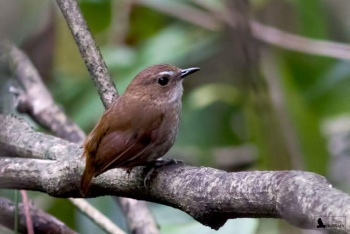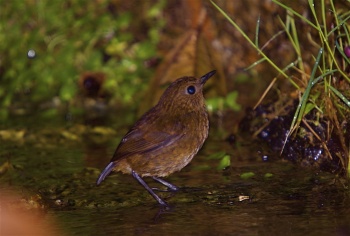m |
(completed, more pictures added) |
||
| Line 1: | Line 1: | ||
| − | {{ | + | [[Image:LesserShortWing.jpg|thumb|550px|right|male subspecies ''wrayi''<br />Photo by {{user|kctsang|kctsang}}<br />[[Fraser's Hill]], Malaysia, March 2008]] |
| − | + | '''Alternative names: Brown Shortwing; Caroline's Shortwing (carolinae); Mrs La Touche's Shortwing (''carolinae'')''' | |
;[[:Category:Brachypteryx|Brachypteryx]] leucophris | ;[[:Category:Brachypteryx|Brachypteryx]] leucophris | ||
| − | |||
==Identification== | ==Identification== | ||
| − | + | [[Image:Lesser_Shortwing.jpg|thumb|350px|right|juvenile ''wrayi''<br />Photo by {{user|kctsang|kctsang}}<br/>[[Fraser's Hill]], Malaysia, July 2006]] | |
| + | 11-13 cm. | ||
| + | * Olive rufous-brown upperparts | ||
| + | * Short white eyebrow (often concealed) | ||
| + | * Very short tail and wings | ||
| + | * Whitish underparts with brownish-buff breast and flanks | ||
| + | * ''nipalensis'' has dull blue-grey upperparts and has dull blue-grey breast and flanks, females are rufous-tinged olive-brown above and have vague pale brown scaling on breast and flanks | ||
| + | * ''carolinae'' looks similar to female ''nipalensis'' (both sexes) but is more rufous above | ||
| + | * ''langbianensis'' like ''carolinae'' but male with supercilium grey at rear and extending farther towards forehead, grey breastband and flanks | ||
| + | * ''wrayi'' is darker, the male has slaty-blue upperparts, breast and flanks, the rest of the underparts are white; female similar to carolinae but with warmer upperparts | ||
| + | Sexes similar but females have weaker white eyebrows and a paler bill bass. Juveniles are similar to adults but spotted. | ||
==Distribution== | ==Distribution== | ||
| − | [[ | + | [[Image:Received 10153863077874358.jpeg|thumb|350px|right|female subspecies ''nipalensis''<br />Photo by {{user|firozhussain|firozhussain}}<br />Missimi Hills, Arunachal Pradesh, [[India]], April 2015]] |
| + | From the [[Himalayas]] east to [[Burma]], south [[China]], [[Indochina]], [[Thailand]], peninsular [[Malaysia]], [[Sumatra]], [[Java]], [[Bali]] and in the [[Lesser Sundas]] (east to Timor).<br /> | ||
| + | Rare in western [[Himalayas]], more common in eastern [[Himalayas]], fairly common in [[Burma]]. Locally common in [[Thailand]], uncommon in [[Malaysia]]. Locally common in [[Sumatra]], [[Java]] and [[Bali]]. | ||
==Taxonomy== | ==Taxonomy== | ||
| + | Five subspecies recognized: | ||
| + | * ''B. l. nipalensis'' in the [[Himalayas]] of north [[India]] to southwest [[China]] (Yunnan) and [[Burma]] | ||
| + | * ''B. l. carolinae'' from south [[China]] to north [[Thailand]] and north [[Indochina]] | ||
| + | * ''B. l. langbianensis'' in the mountains of south [[Laos]] and south [[Vietnam]] | ||
| + | * ''B. l. wrayi'' in the mountains of [[Malaysia]] | ||
| + | * ''B. l. leucophrys'' in the mountains of [[Sumatra]], [[Java]], [[Bali]], Lombok, Sumbawa, Alor and [[Timor]] | ||
==Habitat== | ==Habitat== | ||
| − | + | Montane forest with dense damp undergrowth, often near streams or in ravines.<br /> | |
| + | Occurs mostly from 1500 to 2100 m. Often in dwarf bamboo in [[Vietnam]]. Winters in grassier, scrubbier habitat down to the lowlands (250 m). | ||
==Behaviour== | ==Behaviour== | ||
| + | ====Diet==== | ||
| + | Feeds mainly on insects. In [[Indonesia]] snails, slugs, grubs and beetle pupae. | ||
| + | ====Breeding==== | ||
| + | Breeding season from April to July in the [[Himalayas]], March to June in peninsular [[Malaysia]] and October to April in [[Java]]. The nest is a compact dome with a side entrance. It's made of bamboo, roots, moss and leaves and placed well camouflaged in the vegetation like an orchid clumb, dwarf bamboo or rattan, on or close to the ground.Lays 2 to 4 eggs. Sometimes parasitized by [[Large Hawk Cuckoo]]. | ||
| + | ====Movements==== | ||
| + | This is a resident species with some altitudinal movements in the [[Himalayas]]. Some local short-distance migration seems to be possible. | ||
| + | ==References== | ||
| + | #{{Ref-Clements6thAug14}}#{{Ref-GillDonsker14V5.2}}#Handbook of the Birds of the World Alive (retrieved July 2015) | ||
| + | {{ref}} | ||
==External Links== | ==External Links== | ||
{{GSearch|Brachypteryx+leucophris}} | {{GSearch|Brachypteryx+leucophris}} | ||
[[Category:Birds]] [[Category:Brachypteryx]] | [[Category:Birds]] [[Category:Brachypteryx]] | ||
Revision as of 12:22, 8 July 2015
Alternative names: Brown Shortwing; Caroline's Shortwing (carolinae); Mrs La Touche's Shortwing (carolinae)
- Brachypteryx leucophris
Identification
11-13 cm.
- Olive rufous-brown upperparts
- Short white eyebrow (often concealed)
- Very short tail and wings
- Whitish underparts with brownish-buff breast and flanks
- nipalensis has dull blue-grey upperparts and has dull blue-grey breast and flanks, females are rufous-tinged olive-brown above and have vague pale brown scaling on breast and flanks
- carolinae looks similar to female nipalensis (both sexes) but is more rufous above
- langbianensis like carolinae but male with supercilium grey at rear and extending farther towards forehead, grey breastband and flanks
- wrayi is darker, the male has slaty-blue upperparts, breast and flanks, the rest of the underparts are white; female similar to carolinae but with warmer upperparts
Sexes similar but females have weaker white eyebrows and a paler bill bass. Juveniles are similar to adults but spotted.
Distribution

Photo by firozhussain
Missimi Hills, Arunachal Pradesh, India, April 2015
From the Himalayas east to Burma, south China, Indochina, Thailand, peninsular Malaysia, Sumatra, Java, Bali and in the Lesser Sundas (east to Timor).
Rare in western Himalayas, more common in eastern Himalayas, fairly common in Burma. Locally common in Thailand, uncommon in Malaysia. Locally common in Sumatra, Java and Bali.
Taxonomy
Five subspecies recognized:
- B. l. nipalensis in the Himalayas of north India to southwest China (Yunnan) and Burma
- B. l. carolinae from south China to north Thailand and north Indochina
- B. l. langbianensis in the mountains of south Laos and south Vietnam
- B. l. wrayi in the mountains of Malaysia
- B. l. leucophrys in the mountains of Sumatra, Java, Bali, Lombok, Sumbawa, Alor and Timor
Habitat
Montane forest with dense damp undergrowth, often near streams or in ravines.
Occurs mostly from 1500 to 2100 m. Often in dwarf bamboo in Vietnam. Winters in grassier, scrubbier habitat down to the lowlands (250 m).
Behaviour
Diet
Feeds mainly on insects. In Indonesia snails, slugs, grubs and beetle pupae.
Breeding
Breeding season from April to July in the Himalayas, March to June in peninsular Malaysia and October to April in Java. The nest is a compact dome with a side entrance. It's made of bamboo, roots, moss and leaves and placed well camouflaged in the vegetation like an orchid clumb, dwarf bamboo or rattan, on or close to the ground.Lays 2 to 4 eggs. Sometimes parasitized by Large Hawk Cuckoo.
Movements
This is a resident species with some altitudinal movements in the Himalayas. Some local short-distance migration seems to be possible.
References
- Clements, J. F., T. S. Schulenberg, M. J. Iliff, D. Roberson, T. A. Fredericks, B. L. Sullivan, and C. L. Wood. 2014. The eBird/Clements checklist of birds of the world: Version 6.9., with updates to August 2014. Downloaded from http://www.birds.cornell.edu/clementschecklist/download/
- Gill, F and D Donsker (Eds). 2015. IOC World Bird Names (version 5.2). Available at http://www.worldbirdnames.org/.
- Handbook of the Birds of the World Alive (retrieved July 2015)
Recommended Citation
- BirdForum Opus contributors. (2024) Lesser Shortwing. In: BirdForum, the forum for wild birds and birding. Retrieved 29 May 2024 from https://www.birdforum.net/opus/Lesser_Shortwing





